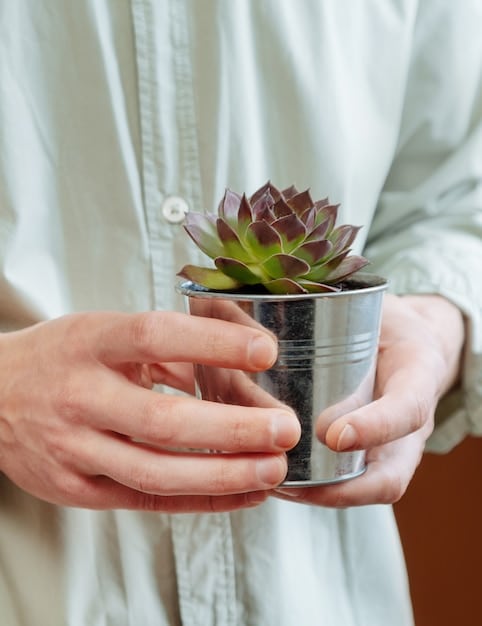Preparing Your Garden for Extreme Weather: A Comprehensive Guide

Preparing your garden for extreme weather involves protecting your plants from frost, heat, and drought through strategies like mulching, choosing resilient species, and implementing efficient watering techniques.
How to Prepare Your Garden for Extreme Weather: Protecting Plants from Frost, Heat, and Drought can seem like a daunting task, but with the right strategies, you can ensure your plants survive and thrive despite challenging conditions.
Understanding Extreme Weather Impacts on Your Garden
Extreme weather events can wreak havoc on gardens, causing significant damage and plant loss. Understanding these impacts is the first step in preparing your garden for such challenges.
Let’s explore the specific threats posed by frost, heat, and drought and how they affect different types of plants.
Frost Damage and Prevention
Frost occurs when temperatures drop below freezing, causing water inside plant cells to freeze and expand. This can lead to cell rupture and tissue damage, often resulting in wilting, discoloration, and even plant death.
- Covering Plants: Use frost blankets, burlap, or old sheets to protect vulnerable plants.
- Mulching: Apply a thick layer of mulch around the base of plants to insulate the soil.
- Watering: Water plants thoroughly before a frost to hydrate cells and provide some insulation.
Heat Stress and Mitigation
Prolonged exposure to high temperatures can cause heat stress in plants, leading to wilting, stunted growth, and reduced fruit production. Excessive heat can also damage plant tissues and make them more susceptible to pests and diseases.
- Shading: Use shade cloths or row covers to protect plants from intense sunlight.
- Watering: Water deeply and frequently to keep soil moist and cool.
- Mulching: Apply mulch to retain soil moisture and regulate temperature.
Drought Resilience Strategies
Drought conditions can severely limit plant growth and survival. Water scarcity leads to reduced photosynthesis, nutrient uptake, and overall plant vigor. Signs of drought stress include wilting, leaf drop, and browning.
- Water Conservation: Implement water-saving techniques like drip irrigation and rainwater harvesting.
- Drought-Tolerant Plants: Choose plant varieties that are naturally adapted to dry conditions.
- Soil Improvement: Amend soil with organic matter to improve water retention.
Understanding these individual impacts allows gardeners to tailor their strategies effectively, mitigating the potential harm from each type of extreme weather.
Choosing the Right Plants for Your Climate
Selecting plant species that are well-suited to your local climate is crucial for creating a resilient garden. Native plants and climate-adapted varieties are often more resistant to extreme weather conditions.
Consider these factors when choosing plants for your garden.
Understanding Hardiness Zones
Hardiness zones are geographical areas defined by average minimum winter temperatures. Knowing your hardiness zone helps you select plants that can survive the coldest temperatures in your region.
The USDA Plant Hardiness Zone Map is a valuable resource for determining your zone and identifying suitable plants.
Selecting Native Plants
Native plants are adapted to the local climate and soil conditions, making them more resilient to extreme weather events. They also support local ecosystems by providing food and habitat for native wildlife.
Local nurseries and extension offices can provide information on native plants suitable for your area.
Climate-Adapted Varieties
In addition to native plants, there are many climate-adapted varieties of common garden plants that are bred for increased resilience to heat, drought, and frost. These varieties offer the benefits of familiar plants with improved hardiness.
Look for varieties with labels indicating heat tolerance, drought resistance, or cold hardiness.

By carefully selecting plants that are well-suited to your climate, you can create a garden that is more resilient to extreme weather and requires less intervention to thrive.
Implementing Efficient Watering Techniques
Efficient watering is essential for maintaining plant health during periods of drought and heat. Proper watering techniques can conserve water and ensure that plants receive the hydration they need.
Let’s explore some effective watering strategies for your garden.
Drip Irrigation Systems
Drip irrigation delivers water directly to the root zone of plants, minimizing water loss through evaporation and runoff. This method is highly efficient and can be easily automated with a timer.
Drip irrigation systems are particularly useful for vegetable gardens, flower beds, and orchards.
Soaker Hoses
Soaker hoses are another efficient watering method that slowly release water directly into the soil. They are ideal for watering rows of plants and can be covered with mulch to further reduce evaporation.
Soaker hoses are a cost-effective option for small to medium-sized gardens.
Watering Timing and Frequency
Watering deeply and less frequently encourages plants to develop deeper root systems, making them more drought-tolerant. Water in the early morning or late evening to minimize evaporation and ensure that plants have time to absorb the water before temperatures rise.
Avoid frequent, shallow watering, which can lead to shallow root growth and increased susceptibility to drought.
By adopting efficient watering techniques, you can conserve water and ensure that your plants receive the hydration they need to withstand extreme weather conditions.
The Importance of Mulching
Mulching is a simple yet highly effective way to protect your garden from extreme weather. Mulch helps to regulate soil temperature, retain moisture, suppress weeds, and improve soil health.
Here’s how mulching can benefit your garden.
Types of Mulch
There are several types of mulch to choose from, each with its own benefits and drawbacks. Organic mulches, such as wood chips, straw, and compost, decompose over time, adding nutrients to the soil. Inorganic mulches, such as gravel and plastic, do not decompose and are better suited for certain applications.
Consider the specific needs of your plants and the aesthetic of your garden when selecting a mulch.
Benefits of Mulching
- Temperature Regulation: Mulch insulates the soil, keeping it cooler in the summer and warmer in the winter.
- Moisture Retention: Mulch reduces evaporation, helping to keep the soil moist during dry periods.
- Weed Suppression: Mulch blocks sunlight, preventing weed seeds from germinating.
Application Techniques
Apply a 2-4 inch layer of mulch around the base of plants, keeping it a few inches away from the stems to prevent rot. Replenish mulch as needed to maintain its effectiveness.
Avoid using too much mulch, as this can suffocate plant roots and create a favorable environment for pests and diseases.

By incorporating mulching into your gardening practices, you can create a more resilient and productive garden that is better able to withstand extreme weather conditions.
Protecting Plants from Frost
Frost can be particularly damaging to tender plants, but there are several steps you can take to protect your garden from freezing temperatures. Preparation and proactive measures are key to safeguarding your plants.
Let’s examine effective frost protection strategies.
Covering Techniques
Covering plants with frost blankets, burlap, or old sheets can provide a layer of insulation, protecting them from freezing temperatures. Ensure that the covers extend to the ground to trap heat and prevent cold air from reaching the plants.
Remove the covers during the day to allow plants to receive sunlight and air circulation.
Cold Frames and Greenhouses
Cold frames and greenhouses provide a more robust form of frost protection, creating a sheltered environment where temperatures remain above freezing. These structures are ideal for protecting delicate plants and extending the growing season.
Ensure that cold frames and greenhouses are properly ventilated to prevent overheating during sunny days.
Watering Strategies
Watering plants thoroughly before a frost can help to hydrate plant cells and provide some insulation. Wet soil retains heat better than dry soil, helping to moderate soil temperatures during cold nights.
Avoid overhead watering, as this can lead to ice formation on plant leaves, causing more damage.
By implementing these frost protection strategies, you can minimize the risk of frost damage and ensure that your plants survive the winter months.
Shielding Your Garden from Excessive Heat
Protecting your garden from excessive heat is crucial during summer months. High temperatures can cause heat stress, wilting, and even plant death. Implementing shade and proper watering techniques can help mitigate these effects.
Let’s look at methods for shielding your garden.
Shade Cloths and Row Covers
Shade cloths and row covers can provide temporary shade, reducing the intensity of sunlight and lowering temperatures around plants. These are particularly useful for protecting sensitive plants from scorching sun.
Choose shade cloths with appropriate light transmission levels for your specific plants.
Strategic Planting
Planting taller plants to provide shade for shorter, more sensitive plants can create a microclimate that is cooler and more humid. This technique, known as companion planting, can help to protect plants from heat stress.
Consider the sun’s path and the height of your plants when planning your garden layout.
Watering Practices
Deep watering in the early morning or late evening can help to keep soil cool and moist, reducing the risk of heat stress. Avoid watering during the hottest part of the day, as much of the water will evaporate before it can be absorbed by plants.
Use mulch to retain soil moisture and regulate soil temperature.
By implementing these heat protection strategies, you can help your garden thrive even during the hottest summer months.
| Key Element | Brief Description |
|---|---|
| 🌱 Plant Selection | Choose native and climate-adapted plants for resilience. |
| 💧 Watering Methods | Use drip irrigation and water deeply during early morning or late evening. |
| 🛡️ Mulching | Apply mulch to regulate temperature, retain moisture, and suppress weeds. |
| 🌡️ Frost Protection | Cover plants or use cold frames to protect from freezing temperatures. |
FAQ
▼
Consider your plant’s needs and garden aesthetics. Organic mulches like wood chips add nutrients to the soil, while inorganic options such as gravel are more permanent. Choose based on what benefits your specific plants.
▼
Water early in the morning or late in the evening. This minimizes water loss from evaporation and ensures plants have enough moisture to withstand temperature changes.
▼
Cover plants with frost blankets or old sheets. Ensure the covers reach the ground to trap heat. Remove them during the day to allow sunlight and air circulation, thus preventing overheating.
▼
Native plants are adapted to your local climate and require less care. They support local ecosystems, resist local pests, and thrive in conditions where other plants may struggle, reducing water consumption.
▼
Yes, drip irrigation is much more effective. It delivers water directly to the roots, reducing water loss due to evaporation and runoff. This ensures plants receive the hydration they need, conserving resources.
Conclusion
Preparing your garden for extreme weather involves a combination of thoughtful planning, strategic techniques, and proactive measures. By understanding the potential impacts of frost, heat, and drought, and implementing appropriate strategies, you can ensure that your plants not only survive but thrive, regardless of the weather challenges.





